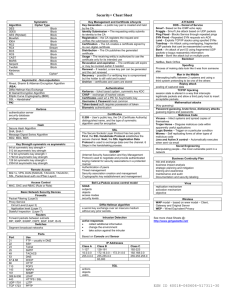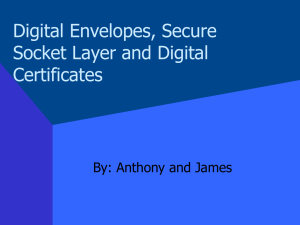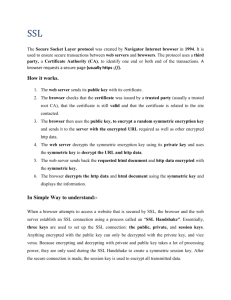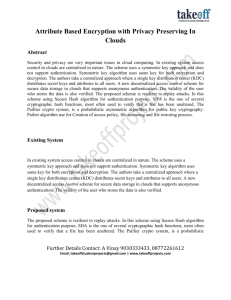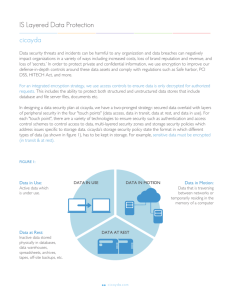Security+ Cheat Sheet
advertisement
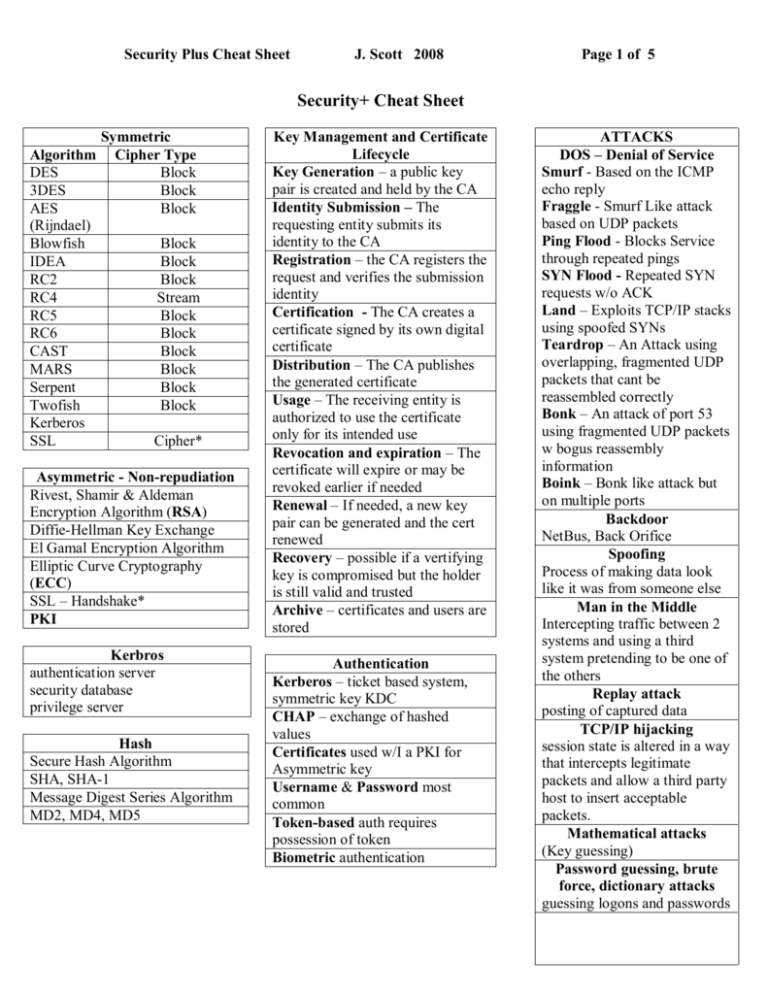
Security Plus Cheat Sheet J. Scott 2008 Page 1 of 5 Security+ Cheat Sheet Algorithm DES 3DES AES (Rijndael) Blowfish IDEA RC2 RC4 RC5 RC6 CAST MARS Serpent Twofish Kerberos SSL Symmetric Cipher Type Block Block Block Block Block Block Stream Block Block Block Block Block Block Cipher* Asymmetric - Non-repudiation Rivest, Shamir & Aldeman Encryption Algorithm (RSA) Diffie-Hellman Key Exchange El Gamal Encryption Algorithm Elliptic Curve Cryptography (ECC) SSL – Handshake* PKI Kerbros authentication server security database privilege server Hash Secure Hash Algorithm SHA, SHA-1 Message Digest Series Algorithm MD2, MD4, MD5 Key Management and Certificate Lifecycle Key Generation – a public key pair is created and held by the CA Identity Submission – The requesting entity submits its identity to the CA Registration – the CA registers the request and verifies the submission identity Certification - The CA creates a certificate signed by its own digital certificate Distribution – The CA publishes the generated certificate Usage – The receiving entity is authorized to use the certificate only for its intended use Revocation and expiration – The certificate will expire or may be revoked earlier if needed Renewal – If needed, a new key pair can be generated and the cert renewed Recovery – possible if a vertifying key is compromised but the holder is still valid and trusted Archive – certificates and users are stored Authentication Kerberos – ticket based system, symmetric key KDC CHAP – exchange of hashed values Certificates used w/I a PKI for Asymmetric key Username & Password most common Token-based auth requires possession of token Biometric authentication ATTACKS DOS – Denial of Service Smurf - Based on the ICMP echo reply Fraggle - Smurf Like attack based on UDP packets Ping Flood - Blocks Service through repeated pings SYN Flood - Repeated SYN requests w/o ACK Land – Exploits TCP/IP stacks using spoofed SYNs Teardrop – An Attack using overlapping, fragmented UDP packets that cant be reassembled correctly Bonk – An attack of port 53 using fragmented UDP packets w bogus reassembly information Boink – Bonk like attack but on multiple ports Backdoor NetBus, Back Orifice Spoofing Process of making data look like it was from someone else Man in the Middle Intercepting traffic between 2 systems and using a third system pretending to be one of the others Replay attack posting of captured data TCP/IP hijacking session state is altered in a way that intercepts legitimate packets and allow a third party host to insert acceptable packets. Mathematical attacks (Key guessing) Password guessing, brute force, dictionary attacks guessing logons and passwords Security Plus Cheat Sheet Key Strength symmetric vs asymmetric 64 bit symmetric key strength = 512 bit asymmetric key strength 112 bit symmetric key strength = 1792 bit asymmetric key strength 128 bit symmetric key strength = 2304 bit asymmetric key strength Remote Access 802.11, VPN, DUN (RADIUS, TACACS, TACACS+, SSL, Packet-level auth via IPSec Layer3 Access Control MAC, DAC and RBAC (Rule or Role) Basic Network Security Devices Firewalls Packet Filtering (Layer3) Proxy Service Circuit Level (Layer 3) Application level (Layer 7) Stateful Inspection (Layer 7) Routers Forward packets between subnets RIP, IGRP, EIGRP, OSPF, BGP, EGP, IS-IS Switches Segment broadcast networks Port 21 22 23 25 49 53 67 & 68 80 110 143 161 389 & 636 443 UDP Ports Use FTP – usually in DMZ SSH Telnet SMTP TACACS DNS DHCP HTTP POP3 IMAP4 SNMP LDAP HTTPS / SSL L2TP J. Scott 2008 Certificates X.509 – User’s public key, the CA (Certificate Authority) distinguished name, and the type of symmetric algorithm used for encryption. SSL The Secure Sockets Layer Protocol has two parts. First, the SSL Handshake Protocol establishes the secure channel. Next, the SSL Application Data Protocol is used to exchange data over the channel. 6 Steps in the handshaking process. ISAKMP (Internet Security Association and Key Management Protocol) used to negotiate and provide authenticated keying material for security associations in a protected manner Authentication of peers Threat management Security association creation and management Cryptographic key establishment and management Bell La-Padula access control model SOAS subjects objects access modes security levels Diffie-Hellman algorithm a secret key exchange over an insecure medium without any prior secrets. Intrusion Detection active responses • collect additional information • change the environment • take action against the intruder Based on Console and Sensor Page 2 of 5 Malicious Code Viruses – Infect systems and spread copies of themselves Trojan Horse – Disguise malicious code within apparently useful applications Logic Bombs – Trigger on a particular condition Worms – Self replicating forms of other types of malicious code Java and Active X control – Automatically executes when sent via email Social Engineering Manipulating people – the most vulnerable point in a network Business Continuity Plan risk and analysis business impact analysis strategic planning and mitigation training and awareness maintenance and audit Documentation and security labeling Virus replication mechanism activation mechanism objective Wireless WAP model – based on www model – Client, Gateway and Original Server WEP – Wired Equivalent Privacy Security Plus Cheat Sheet 1701 TCP 1723 PPTP SQL actions objects users § § § § § § § § § § § § § § § J. Scott 2008 Page 3 of 5 IP Addresses Class A Class B Class C 1-127 128-191 192-223 10.0.0.0 172.16.0.0 192.168.0.0 – 172.31.0.0 255.0.0.0 255.255.0.0 255.255.255.0 65,000 Integrity - Assuring the recipient that a message has not been altered in transit. ensures all data is sequenced, and numbered. PPTP only works over IP. Asymmetric encryption scheme relies on both the sender and receiver to use different keys to encrypt and decrypt messages. Encryption and authentication can take place without sharing private keys. encrypt symmetric keys The integrity of a cryptographic system is considered compromised if the private key is disclosed. WTLS (Wireless Transport Layer Security) provides privacy, data integrity and authentication for handles devices in a wireless network environment. File encryption using symmetric cryptography satisfies authentication The primary DISADVANTAGE of symmetric cryptography is key distribution. SYN Flood - A network attack that misuses TCP’s (Transmission Control Protocol) three way handshake to overload servers and deny access to legitimate users. When a user digitally signs a document an asymmetric algorithm is used to encrypt hash results Least privilege – need to know security basis. Applying ingress filtering to routers is the best method to prevent ip spoofing attacks. MD5 (Message Digest 5) - A common algorithm used to verify the integrity of data from a remote user through a the creation of a 128-bit hash from a data input Worms are self replicating, Trojans are not. Message authentication codes are used to provide integrity. False positive - Incorrectly detecting authorized access as an intrusion or attack. § § § § § § § § § § § § § § Audit Log - A collection of information that includes login, file access, other various activities, and actual or attempted legitimate and unauthorized violations VLAN - originally designed to decrease broadcast traffic but is also beneficial in reducing the likelihood of having information compromised by sniffers Active detection IDS systems may break off suspicious connections or shut down the server or service CRL and OCSP - two common methods when using a public key infrastructure for maintaining access to servers in a network IPSec Provides the Authentication Header (AH) for data integrity and Encapsulation Security Payload (ESP) for data confidentiality. TCP SYN scan - used to see what ports are in a listening state and then performs a two way handshake NAT (Network Address Translation) can be accomplished with static and hide NAT (Network Address Translation) and PAT (Port Address Translation) Due care - Policies and procedures intended to reduce the likelihood of damage or injury Business impact analysis - obtain formal agreement on maximum tolerable downtime Documenting change levels and revision information is most useful for Disaster recovery worm is able to distribute itself without using a host file Single servers are frequently the targets of attacks because they contain credentials for many systems and users Multi-factor authentication may be needed when a stored key and memorized password are not strong enough and additional layers of security is needed VPN Drawback - a firewall CAN NOT inspect encrypted traffic Security Plus Cheat Sheet § § § § § § § § § § § § • § § § § § J. Scott 2008 ICMP quoting - What fingerprinting technique relies on the fact that operating systems differ in the amount of information that is quoted when ICMP (Internet Control Message Protocol) errors are encountered SSL - protocol typically used for encrypting traffic between a web browser and web server. Available in 40 and 128 bit encryption. IPSec - a popular VPN (Virtual Private Network) protocol operating at OSI (Open Systems Interconnect) model Layer 3. Digital signatures provide authentication and nonrepudiation - not confidentiality. DAC (Discretionary Access Control) relies only on the identity of the user or process. Each object has an owner, which has full control over the object Access controls that are created and administered by the data owner MAC - Access controls based on security labels associated with each data item and each user. use levels of security to classify users and data DEN is not inferior to SNMP Kerberos - Time synchronization services for clients and servers.. A malformed MIME (Multipurpose Internet Mail Extensions) header can cause an email server to crash. Passive detection – analyzing log files after an attack begins. the best defense against man in the middle attacks is strong encryption, auth Systems identified in a formal risk analysis process should be included in a disaster recover plan. Certificate policy - A PKI (Public Key Infrastructure) document that serves as the vehicle on which to base common interoperability standards and common assurance criteria on an industry wide basis. Buffer overflow – sends more traffic to a node than anticipated. Differential backup methods copies only modified files since the last full backup IM is a peer-to-peer network that offers most organizations virtually no control over it. Most vulnerable to sniffing Decentralized privilege management environment, user accounts and passwords are stored on each individual server. A FTP bounce attack is generally used to establish a connection between the FTP server and another computer § § § § § § § § § § § § § § § § § § § § Page 4 of 5 man trap - physical access control most adequately protects against physical piggybacking LDAP directories are arranged as Trees Data integrity is best achieved using a Message digest minimum length of a password be to deter dictionary password cracks 8 CRL certificates that have been disabled before their scheduled expiration. logging - to keep a record of system usage Security controls may become vulnerabilities in a system unless they are adequately tested RBAC Access control decisions are based on responsibilities that an individual user or process has in an organization The start of the LDAP directory is called the root HAS encryption - 128 bits. SSLv3.0 (Secure Sockets Layer version 3.0) added the ability to force client side authentication via digital certificates virus - replication mechanism, activation mechanism and objective Hashed passwords subject to man in the middle attacks *The Secure Sockets Layer (SSL) protocol uses both asymmetric and symmetric key exchange. Use asymmetric keys for the SSL handshake. During the handshake, the master key, encrypted with the receiver public passes from the client to the server. The client and server make their own session keys using the master key. The session keys encrypt and decrypt data for the remainder of the session. Symmetric key exchange occurs during the exchange of the cipher specification, or encryption level. PKI technical solution for reducing the threat of a man in the middle attack CRL (Certificate Revocation List) query that receives a response in near real time does not guarantee that fresh data is being returned. multi-homed firewall If the firewall is compromised, only the systems in the DMZ (The main purpose of digital certificates is to bind a public key to the entity that holds the corresponding private key One of the factors that influence the lifespan of a public key certificate and its associated keys is the Length of the asymmetric hash. In order for a user to obtain a certificate from a trusted CA (Certificate Authority), the user must present proof of identity and a Public key What is the primary DISADVANTAGE of a third party relay Spammers can utilize the relay. Security Plus Cheat Sheet § § § § § § § § § § § § § § § § § J. Scott 2008 Network Based IDS - a system for an internal network that will examine all packets for known attack signatures. Ping of Death Attack A network attack method that uses ICMP (Internet Control Message Protocol) and improperly formatted MTUs (Maximum Transmission Unit) to crash a target computer By SSO, the authentication problem of multiple usernames and passwords is addressed, browse multiple directories PKI (Public Key Infrastructure) - the best technical solution for reducing the threat of a man in the middle attack Security controls may become vulnerabilities in a system unless they are adequately tested. The standard encryption algorithm based on Rijndael is known as AES. misuse detection - Management wants to track personnel who visit unauthorized web sites. Hosting included in a SLA (Service Level Agreement) to ensure the availability of server based resources rather than guaranteed server performance levels SSL uses an asymmetric key and operates at the session layer RAID supports High Availability Common Criteria - The defacto IT (Information Technology) security evaluation criteria for the international community Crime scene technician - Tag, bag, and inventory evidence Extranet - allows a business to securely transact with other businesses Controlling access to information systems and associated networks is necessary for the preservation of their Confidentiality, integrity and availability (Their CIA) dual key pair - Using distinct key pairs to separate confidentiality services from integrity services to support non-repudiation Single Loss Expectancy - SLE - is the cost of a single loss when it occurs - compiling estimates on how much money the company could lose if a risk occurred one time in the future. Non-repudiation is generally used to prevent the sender or the receiver from denying that the communication between them has occurred § § § § § § § § § § § § § § § § § Page 5 of 5 The greater the keyspace and complexity of a password, the longer a attack may take to crack the password brute force The WAP (Wireless Application Protocol) programming model is based on the following three elements Client, gateway, original server What is a good practice in deploying a CA (Certificate Authority create a CPS (Certificate Practice Statement). What is the default transport layer protocol and port number that SSL (Secure Sockets Layer) uses TCP (Transmission Control Protocol) transport layer protocol and port 443 What has 160-Bit encryption? SHA-1 Which of the following is typically included in a CRL certificates that have been disabled before their scheduled expiration DDoS (Distributed Denial of Service) is most commonly accomplished by multiple servers or routers monopolizing and over whelming the bandwidth of a particular server or router. IMAP4 requires port ____ to be open 143 During the digital signature process, hashing provides a means to verify what security requirement data integrity File encryption using symmetric cryptography satisfies what security requirement Authentication Which authentication protocol could be employed to encrypt passwords CHAP (Challenge Handshake Authentication Protocol) When User A applies to the CA (Certificate Authority) requesting a certificate to allow the start of communication with User B, User A must supply the CA (Certificate Authority) with User A’s public key only Demilitarized Zone) are exposed A common algorithm used to verify the integrity of data from a remote user through a the creation of a 128-bit hash from a data input is MD5 (Message Digest 5) Firewall to allow employees in the company to DL FTP – set outbound port 23 allowed SYN Attack – exploits in the hand shaking Confidentiality - The protection of data against unauthorized access or disclosure

